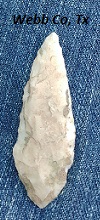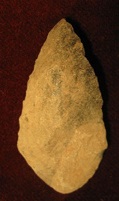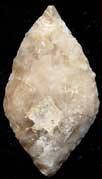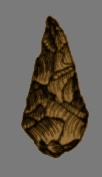Outline is Representative of Size and Shape:

Name Details:
Identified By: Dee Ann Suhm, Alex D. Krieger, Edward B. Jelks
Named For: Local Collector who first identified the type, William "Dizzy" Desmuke
Date Identified: 1954
Type Site:
Identified By: Dee Ann Suhm, Alex D. Krieger, Edward B. Jelks
Named For: Local Collector who first identified the type, William "Dizzy" Desmuke
Date Identified: 1954
Type Site:
Point Validity:
Valid type
Suhm was an eminent Texas anthropologist who, among many distinguished positions, served as Director of Texas Archaeological Research Laboratory. Krieger was a renowned anthropologist who spent most of his career in Texas cataloging projectile points and pottery in Texas before moving on to the University of Washington. Jelks was a distinguished anthropologist and helped organize the newly formed Department of Anthropology at Illinois State University where he was a Professor. His work in Texas furthered the understanding of Texas archeology and was a founding force for the Society of Historical Archeology. This point was named in a professional publication and has many professional references. This is a valid type.
Suhm was an eminent Texas anthropologist who, among many distinguished positions, served as Director of Texas Archaeological Research Laboratory. Krieger was a renowned anthropologist who spent most of his career in Texas cataloging projectile points and pottery in Texas before moving on to the University of Washington. Jelks was a distinguished anthropologist and helped organize the newly formed Department of Anthropology at Illinois State University where he was a Professor. His work in Texas furthered the understanding of Texas archeology and was a founding force for the Society of Historical Archeology. This point was named in a professional publication and has many professional references. This is a valid type.
Desmuke Diamond
Cluster: Description of Physical Characteristics and Flaking Pattern:
This is a thick small to medium lozenge-shaped contracting stem point. The cross section may range from a thick elliptical to diamond with a medial ridge running down both faces. The blade is primarily straight to excurvate with the widest part of the blade at the shoulders edge or about one third of the blade from the base. Many examples have one blade beveled on each face and may be serrated. The shoulders are absent. The stem is contracting with a convex to pointed base. One basal edge is commonly straighter while the other edge is more excurvate. This point is made using course percussion flaking and limited pressure flaking along the edges.
Size Measurements:
Length - 30 to 50 mm, Width - 15 to 25 mm (Suhm and Krieger, 1954)
Length - 30 to 50 mm, Width - 15 to 25 mm (Suhm and Krieger, 1954)
Commonly Utilized Material:
White Quartzite and various cherts
White Quartzite and various cherts
Additional Comments:
Distribution: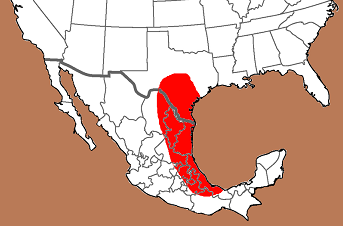

Distribution Comments:
This point is primarily found in the Frio and Nueces River valleys and lower Rio Grande River Valley of Texas and Mexico. This point is found with decreased frequency into the coastal regions and into central Texas. Has been reported into the Valley of Mexico
This point is primarily found in the Frio and Nueces River valleys and lower Rio Grande River Valley of Texas and Mexico. This point is found with decreased frequency into the coastal regions and into central Texas. Has been reported into the Valley of Mexico
Age / Periods:
Date: 3,000 - 2,000 B.P.
Cultural Period: Late to Transitional Archaic
Glacial Period: Neoglacial to Roman Warm
Culture:
Date: 3,000 - 2,000 B.P.
Cultural Period: Late to Transitional Archaic
Glacial Period: Neoglacial to Roman Warm
Culture:
Age Details:
Similar Points:
Abasolo, Chiconautla, Desmuke, Gary, Gypsum Cave, Harahey, Hayes Grande, Lermoide, Lerma, Nodena, Refugio, Zacatenco
Abasolo, Chiconautla, Desmuke, Gary, Gypsum Cave, Harahey, Hayes Grande, Lermoide, Lerma, Nodena, Refugio, Zacatenco

